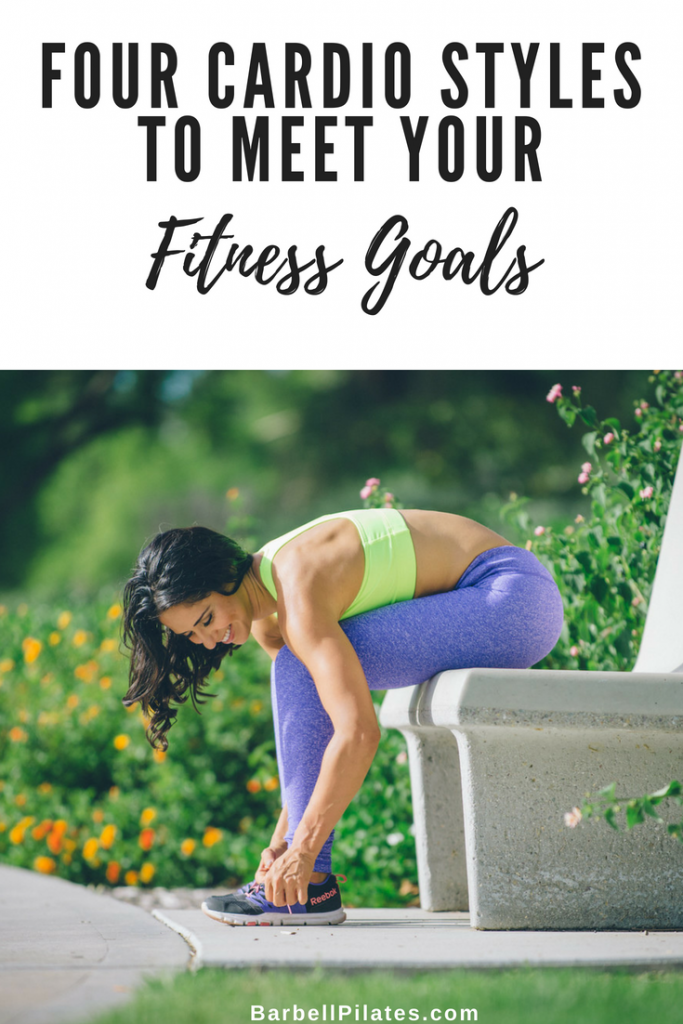As a former runner turned powerlifter turned generalist (what can I say, I love all the fitness!), nothing says “no fucking way” quite like the word “cardio.” The word brings me back to my 6-mile days on the treadmill – THE TREADMILL! — and half-marathon training sessions in the freezing Boston cold or pouring rain.
Good times.

At the time, long steady-state cardio made sense for me. My goal after all was to run lonnnnnnnggggg miles in preparation for a race, so building up that endurance was paramount. Unfortunately, the term “cardio has become synonymous with this style of training. Many people think that the more he or she spends on cardio, the more in shape or leaner he/she’ll be.
I certainly used to think that, which is how I got into running.
The reality is cardiovascular training isn’t that black and white. Choosing the right type of cardio training depends on your goal, lifestyle, and availability.
Here is a quick guide to help you determine the best type of cardio training style for your fitness goal.
The Four Types of Trainees
The Generalist
The generalist is someone who wants to look good, have some level of aerobic capacity but isn’t all that concerned with performance or athleticism. Generalists aren’t competing at local meets or trying to get a six-pack; they’re usually beginners or active individuals with busy lives who don’t want to sacrifice all their free time at the gym.
Best bet: Circuit training
Circuit training works best for time-crunched generalists because it allows you to focus on strength training in a way that elevates your heart rate and challenges your cardiovascular system at the same time. In this case, strength training and efficiency take precedent over traditional cardio, like running, biking, or swimming. Generalists may still participate in those things, it simply won’t be the priority.
Simply group 5-6 exercises together and rock them back to back with no rest until the end of the set. If you’re short on time you can do a workout like this in 30 minutes or less, so it’s a great way to get a quick workout in as well.
The Meathead
Meatheads love muscle, love lifting, love looking fit, swole, or ripped, and would rather eat a shit sandwich than spend an hour in a spin class. With that said, meatheads know the importance of building solid aerobic capacity, but don’t want it to take over their training sessions because, well, muscles. Meatheads don’t typically love doing cardio anyway so the shorter it is, the better.
Best bet: HIIT 2-3x a week
High-intensity interval training is one of the most efficient methods for meatheads who are more concerned with maintaining muscle mass than building endurance. The nice thing about it is that sessions can range from as little as 10 minutes to 45 minutes, using any equipment you like.
For example, on Tuesday you might do 15-minute sprints at a 30 sec on/30 sec off. Here you can use a treadmill, track, Airdyne bike, rowing machine, basically anything you want. Wednesday, the meathead does meathead things, and on Thursday, she hits a Tabata class for 45 minutes.
Due to HIIT’s intensity, 2-3 sessions is plenty. There should also be at least 24 hours of recovery between HIIT sessions, which is another reason we only do it a few times a week.
The Fat Loss Candidate
If your primary goal is fat loss, resistance training and nutrition are the most important things you’ll focus on. Cardio remains an important factor and thankfully, this individual can use a couple of options depending on their experience level.
Best bet: Circuit training and/or “hard” finishers
As I mentioned before, circuit training is an excellent way to work on aerobic capacity, especially for beginners who are focused on fat loss. For more intermediate people, I like to add in finishers at the end of a workout. These are short, 5-10 minutes of 2-3 exercises that I add at the very end of a training session. Typically, there are zero breaks during a finisher because of the short amount of time. It’s focused, it’s intense, and since it happens at the end of a strength training workout, there’s no need to add on an extra day of cardio.
You can choose from ballistic movements like kettle bell swings, to battle ropes, to wall balls – finishers can be as simple or as creative as you like. If you’re lifting 4x a week, I might add a finisher at the end of 2-3 sessions.
The Well-Rounded Athlete
The well-rounded athlete is somewhere between a generalist and a meathead, expect this individual cares about performance and wants to progress in the skills department. This trainee tends to be more advanced than the generalist but not as one-track minded as the meathead.
The well-rounded [wannabe or current] athlete tends to have a diverse training background, which is why they want to work on all aspects of their fitness (conditioning, strength, flexibility, athleticism) without losing all the strength and skills they’ve earned over years of hard work. I see a lot of former competitors fall into this category in their mid-30s to 40s, and it’s a great place to be as a trainee because it opens up a lot of training doors for someone with a lot of interests and skills.
Best bet: HIIT, finishers, and/or metcon workouts
With strength still a primary goal, the well-rounded athlete has little time to spend on long steady-state cardio sessions. But her diverse background means she can switch between HIIT, finishers, or metabolic conditioning workouts.
Now you may be wondering what the difference is between HIIT and Metabolic conditioning. The short version:
HIIT: Work at a high intensity (say 90% effort) followed by a period of set rest for a set amount of intervals. Tabata is a great example of a HIIT-style workout.
MetCon: Workout at an intense effort for a sustained period of time (say, 20 minutes) with little to no defined rest periods. Workouts typically involve gymnastics movements, weightlifting, and power training in one. A term popularized by CrossFit, metabolic conditioning workouts can improve body composition and leave you lying in a pool of your own sweat and tears. What’s not to love?!
A combination of HIIT training or hard finishers 2-3x a week will go a long way in improving aerobic capacity without interfering with muscle mass, strength, or performance. This individual must also spend more time on mobility training, and that can come in the form of Pilates, yoga, or drills — basically anything you enjoy.
These trainees’ workout sessions might differ week to week: They might do a CrossFit class 2x a week, a powerlifting session 1-2x a week, and add in a combination of HIIT or finishers based on what they’ve done so far in a week. There’s a lot of ways to structure a workout plan for the well-rounded athlete but generally speaking, these folks do best with short burst of intensity that mixes weights, bodyweight, and sprints.
But what about steady-state cardio?
When I think of steady-state cardio, I think about improving general heart health and aerobic activity, which is important for any human to train and maintain. Where we lose ourselves, however, is equating stead-state cardio with long duration (anything more than an hour) exercise. The mentality is “more is better.”
You can still reap the benefits of steady-state cardio without devoting hours of your life to it by:
- Going for a long walk with your dog or kids
- Hiking
- Walking or jogging for 20-30 minutes
- Walking up an incline at the end of your workout at an moderate intensity level
If you’re training for an endurance event, like a 10k, triathlon, or marathon, then yes, you should spend more time doing this form of cardio. Also, if you enjoy going on long runs or bike rides, I say go for it. Just bear in mind that if the goal is fat loss or gaining muscle, long duration steady-state cardio might actually be detrimental to achieving your goals.
